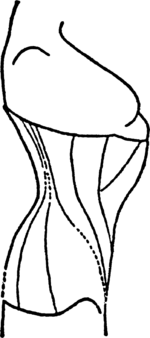March 26, 1910
applied to the anterior surface of the neck at the level of the seventh cervical vertebra. The position of this curve on the chart is ascertained by using as points of reference the horizontal distances between the posterior parts of the seventh cervical and fifth lumbar vertebræ and the points horizontally opposite on the ventral surface, measured on the subject by a pelvimeter or other calipers.
It would be very desirable that this graphic record should be completed in every instance by a representation of the inclination of the brim of the pelvis, which would, of course, include its relation to the trochanter, but after much experimentation we have been unable to measure with accuracy the inclination of the pelvic brim in the living subject.
The use of the profile curves in the graphic representation involves the disadvantage that the chart must be drawn life size, but it can be reduced later by a pantograph to any desired size. The change effected in an individual by treatment or apparatus may be most convincingly displayed by the reproduction of its record on the same chart, as in the figures shown in the clinical section later.
The sources of error incident to the method have been carefully studied. They are swaying of the subject, errors in measurement from the vertical plane, distortion of attitude during observation, inaccuracy in locating on the skin the bony landmarks selected, varying position of the feet, horizontal rotation of the pelvis and psychical influences. These errors and their prevention are dealt with at some length in the original description of the method, and therefore need not be repeated here.
OTHER METHODS OF STUDY USED
At the beginning of our study we experimented with various methods which proved to he worthless for exact use. These were shadowgraphs, observations with plumb lines, study of the model standing on a glass plate by means of a reflected image in a mirror placed underneath and measurements from an upright without knowing the center of gravity. Photographs were largely used, at first without success, but later, by making two exposures on the same plate with the greatest care to prevent jar of the camera, two positions of the model could be recorded with accuracy, but any such composite photograph which showed any duplication of outline of the feet was rejected. Such photographs were mainly used in checking the accuracy of our results from our final apparatus.
Out of several hundred observations made mainly by the apparatus described, we finally selected two hundred as reliable for study, which form the basis of our present communication.
MATERIAL STUDIED
The study was made for the most part on female nude professional artists' models courteously sent to us by the School of the Boston Museum of Fine Arts. In the three and a half years some six of these were under observation, our study of one model at first lasting for months, while, toward the end, two or three were under observation during a fortnight. We selected female rather than male models because they were more easily obtained and more reliable, also because the condition under study occurs much more frequently in women.
Professional models, although clearly the only available material for our purpose, present certain disadvantages which we recognized. They are necessarily of stable types of figures, as otherwise the long-continued assumption of one position necessitated by their occupation would be intolerable, whereas we should have preferred to study women of the unstable types of figure. Another obstacle lay in their desire to help us, and we had carefully to conceal from them the purpose of our inquiry. Another difficulty lay in their ability and readiness to assume fixed unnatural positions, which in posing for artists they are, of course, compelled to do. We therefore supplemented the observations on these by such observations on patients as could be made without undue exposure, and a few such on normal persons, which have also been utilized in formulating our conclusions. These observations were then studied in detail, carefully correlated and analyzed.

DEFINITION OF FIELD OF EXPERIMENTAL STUDY
A consideration of the results of our physiologic study led us to the conclusion that antero-posterior balance in the upright position is maintained by moderate tonicity of the posterior musculature exerted against a slightly anterior position of the center of gravity. Reasoning from this led us to further experiments and observations, to be presently detailed, which seem to us to show that an important element in all static backache is to be found in back-strain, and that to assume relaxation of the sacro-iliac joints to account for the symptoms found is neither necessary nor wholly satisfactory. As soon,


